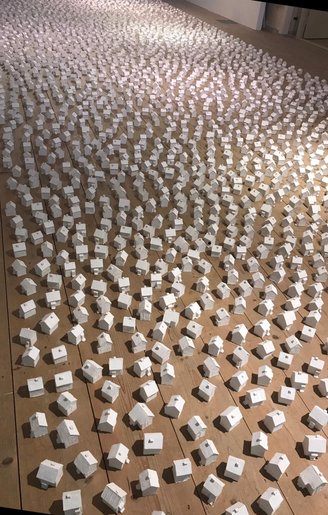“Finland
opted to give housing to the homeless from the start, nationwide, so
as to allow them a stable environment to stabilize their lives.”
— Christian Science Monitor, 3/21/18
###

7,000 model homes, one for each of Finland’s homeless population, in the Suomenlinna Visitor Center & Gallery, Finland. (Barry Evans)
To walk into a vast room whose wooden floor was covered with many, many miniature houses is a surreal experience. Knowing nothing about the art installations awaiting, I casually roamed around an exhibit on an island near Helsinki admiring (or disdaining) paintings, sculptures and elaborate mobiles, until I walked into the last room. A tiny multilingual sign at one end explained that the artist had hand-made 7,000 miniature houses to symbolize and draw attention to Finland’s homeless population which numbered (in early 2018) 7,000.
That figure may actually sound worse than it is, and is a huge improvement on the situation 30 years ago when the country — total population five-and-a-half million — had 18,000. Of the 7,000 currently homeless, some 5,000 live in temporary quarters with friends or family, leaving 2,000 chronically homeless. In a word, Finland has the problem beat, while the rest of Europe’s (and America’s) homeless increases year by year.
Finland is an unusual country, having had more than its fair share of invasions, occupations and land grabs — the most recent example being in 1941, when the Soviet Union took a large (and rich) chunk out of the country — Karelia — and made it part of the USSR. Relations with Russia have been testy ever since, but the Finns have managed to successfully straddle the east-west divide; for instance, they’re not technically part of NATO, but are in the European Union. The Finns topped the 2018 “World Happiness Report” poll, so Finland is officially the happiest country on Earth. (Since you asked, the US is 18th — down from 13th in 2016 — despite having a much higher GDP than Finland.)
Ten years ago, the government took serious stock of its worsening chronic homeless situation. A committee set up to review the predicament recommended adopting the Pathways to Housing model pioneered by Dr. Sam Tsemberis in New York City during the 1990s. (Using a similar approach, Utah’s homeless problem has essentially disappeared.)
In a nutshell, the approach is to first house, then fix, rather than the other way around. “…housing is a prerequisite that will also enable solving a homeless person’s other problems,” according to the committee. So instead of the usual near-universal approach, which insists that a homeless person is only eligible for a state-provided home after they’ve cleaned up their act and can prove they’re clean and sober, the Finnish model is to first get them into a communal home where trained staff provides 24/7 care and detox help. Not to mention the support available from others in the home.
Remarkably, the program more than pays for itself. The CSM cites a 2011 report from the Tampere University of Technology showing that every formerly homeless person now in subsidized rental apartment saved the government $18,500 per year, mainly in medical and emergency services. Also, the program is seeing increasing numbers of residents rehabilitated and entering “regular” society.
I’m reminded of the old saw, “If it’s not working, do something different.” Finland — happy Finland — did something different, on a nationwide basis. The results speak for themselves. Dare we try such a radical approach in this corner of California?
CLICK TO MANAGE